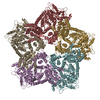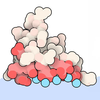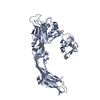+ Open data
Open data
- Basic information
Basic information
| Entry | Database: PDB / ID: 5jzt | ||||||
|---|---|---|---|---|---|---|---|
| Title | Cryo-EM structure of aerolysin pore in LMNG micelle | ||||||
 Components Components | Aerolysin | ||||||
 Keywords Keywords | TOXIN / pore forming toxin / concentric beta-barrel / aerolysin | ||||||
| Function / homology |  Function and homology information Function and homology informationsymbiont-mediated cytolysis of host cell / toxin activity / host cell plasma membrane / extracellular region / identical protein binding / membrane Similarity search - Function | ||||||
| Biological species |  Aeromonas hydrophila (bacteria) Aeromonas hydrophila (bacteria) | ||||||
| Method | ELECTRON MICROSCOPY / single particle reconstruction / cryo EM / Resolution: 7.4 Å | ||||||
 Authors Authors | Iacovache, I. / Zuber, B. | ||||||
| Funding support |  Switzerland, 1items Switzerland, 1items
| ||||||
 Citation Citation |  Journal: Nat Commun / Year: 2016 Journal: Nat Commun / Year: 2016Title: Cryo-EM structure of aerolysin variants reveals a novel protein fold and the pore-formation process. Authors: Ioan Iacovache / Sacha De Carlo / Nuria Cirauqui / Matteo Dal Peraro / F Gisou van der Goot / Benoît Zuber /    Abstract: Owing to their pathogenical role and unique ability to exist both as soluble proteins and transmembrane complexes, pore-forming toxins (PFTs) have been a focus of microbiologists and structural ...Owing to their pathogenical role and unique ability to exist both as soluble proteins and transmembrane complexes, pore-forming toxins (PFTs) have been a focus of microbiologists and structural biologists for decades. PFTs are generally secreted as water-soluble monomers and subsequently bind the membrane of target cells. Then, they assemble into circular oligomers, which undergo conformational changes that allow membrane insertion leading to pore formation and potentially cell death. Aerolysin, produced by the human pathogen Aeromonas hydrophila, is the founding member of a major PFT family found throughout all kingdoms of life. We report cryo-electron microscopy structures of three conformational intermediates and of the final aerolysin pore, jointly providing insight into the conformational changes that allow pore formation. Moreover, the structures reveal a protein fold consisting of two concentric β-barrels, tightly kept together by hydrophobic interactions. This fold suggests a basis for the prion-like ultrastability of aerolysin pore and its stoichiometry. | ||||||
| History |
|
- Structure visualization
Structure visualization
| Movie |
 Movie viewer Movie viewer |
|---|---|
| Structure viewer | Molecule:  Molmil Molmil Jmol/JSmol Jmol/JSmol |
- Downloads & links
Downloads & links
- Download
Download
| PDBx/mmCIF format |  5jzt.cif.gz 5jzt.cif.gz | 500.9 KB | Display |  PDBx/mmCIF format PDBx/mmCIF format |
|---|---|---|---|---|
| PDB format |  pdb5jzt.ent.gz pdb5jzt.ent.gz | 421.8 KB | Display |  PDB format PDB format |
| PDBx/mmJSON format |  5jzt.json.gz 5jzt.json.gz | Tree view |  PDBx/mmJSON format PDBx/mmJSON format | |
| Others |  Other downloads Other downloads |
-Validation report
| Arichive directory |  https://data.pdbj.org/pub/pdb/validation_reports/jz/5jzt https://data.pdbj.org/pub/pdb/validation_reports/jz/5jzt ftp://data.pdbj.org/pub/pdb/validation_reports/jz/5jzt ftp://data.pdbj.org/pub/pdb/validation_reports/jz/5jzt | HTTPS FTP |
|---|
-Related structure data
| Related structure data |  8187MC  8185C  8188C  5jzhC  5jzwC M: map data used to model this data C: citing same article ( |
|---|---|
| Similar structure data |
- Links
Links
- Assembly
Assembly
| Deposited unit | 
|
|---|---|
| 1 |
|
- Components
Components
| #1: Protein | Mass: 47185.152 Da / Num. of mol.: 7 Source method: isolated from a genetically manipulated source Source: (gene. exp.)  Aeromonas hydrophila (bacteria) / Gene: aerA / Production host: Aeromonas hydrophila (bacteria) / Gene: aerA / Production host:  |
|---|
-Experimental details
-Experiment
| Experiment | Method: ELECTRON MICROSCOPY |
|---|---|
| EM experiment | Aggregation state: PARTICLE / 3D reconstruction method: single particle reconstruction |
- Sample preparation
Sample preparation
| Component | Name: aerolysin pore / Type: COMPLEX Details: Aerolysin oligomer in it's pore conformation in LMNG micelles. Entity ID: all / Source: RECOMBINANT |
|---|---|
| Molecular weight | Value: 0.35 MDa / Experimental value: NO |
| Source (natural) | Organism:  Aeromonas hydrophila (bacteria) Aeromonas hydrophila (bacteria) |
| Source (recombinant) | Organism:  |
| Buffer solution | pH: 7.4 |
| Specimen | Conc.: 0.4 mg/ml / Embedding applied: NO / Shadowing applied: NO / Staining applied: NO / Vitrification applied: YES |
| Specimen support | Grid material: COPPER / Grid mesh size: 300 divisions/in. / Grid type: Quantifoil R2/1 |
| Vitrification | Instrument: FEI VITROBOT MARK IV / Cryogen name: ETHANE / Humidity: 70 % / Chamber temperature: 295 K Details: 30 seconds glow discharged grids, 4ul sample, 5 seconds blot |
- Electron microscopy imaging
Electron microscopy imaging
| Experimental equipment |  Model: Tecnai F20 / Image courtesy: FEI Company |
|---|---|
| Microscopy | Model: FEI TECNAI F20 |
| Electron gun | Electron source:  FIELD EMISSION GUN / Accelerating voltage: 200 kV / Illumination mode: FLOOD BEAM FIELD EMISSION GUN / Accelerating voltage: 200 kV / Illumination mode: FLOOD BEAM |
| Electron lens | Mode: BRIGHT FIELD |
| Image recording | Average exposure time: 1 sec. / Electron dose: 22.42 e/Å2 / Detector mode: INTEGRATING / Film or detector model: FEI FALCON II (4k x 4k) |
- Processing
Processing
| EM software |
| ||||||||||||||||||||||||||||||||||||||||
|---|---|---|---|---|---|---|---|---|---|---|---|---|---|---|---|---|---|---|---|---|---|---|---|---|---|---|---|---|---|---|---|---|---|---|---|---|---|---|---|---|---|
| CTF correction | Type: PHASE FLIPPING AND AMPLITUDE CORRECTION | ||||||||||||||||||||||||||||||||||||||||
| Particle selection | Num. of particles selected: 29079 | ||||||||||||||||||||||||||||||||||||||||
| 3D reconstruction | Resolution: 7.4 Å / Resolution method: FSC 0.143 CUT-OFF / Num. of particles: 27108 / Symmetry type: POINT | ||||||||||||||||||||||||||||||||||||||||
| Atomic model building | Protocol: FLEXIBLE FIT | ||||||||||||||||||||||||||||||||||||||||
| Atomic model building | PDB-ID: 3C0N Pdb chain-ID: B / Accession code: 3C0N / Source name: PDB / Type: experimental model |
 Movie
Movie Controller
Controller












 PDBj
PDBj





